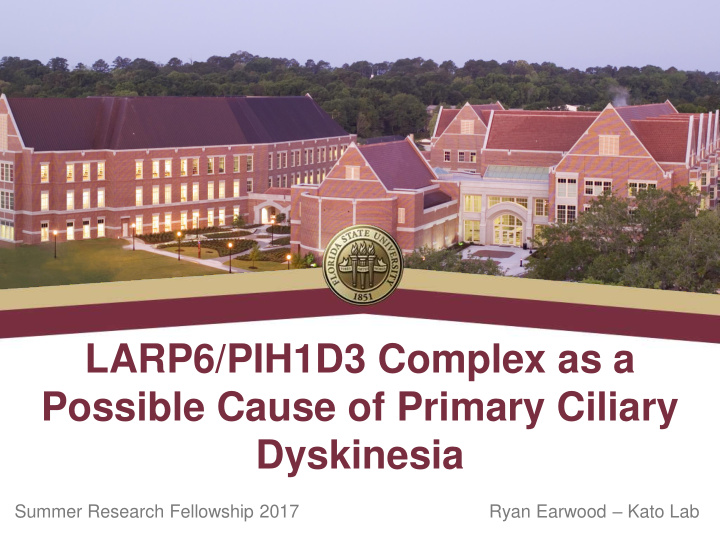



LARP6/PIH1D3 Complex as a Possible Cause of Primary Ciliary Dyskinesia Summer Research Fellowship 2017 Ryan Earwood – Kato Lab
CILIA
Background Krisch, 2014 Ke & Yang, 2014 Benmerah, et al , 2015
Ciliopathies Physiopaedia Radiopaedia Gleeson, 2011
PIH1D3 • X-Linked form of human PCD • Contains CS domain • Localizes to apical cytoplasm • Leads to dysfunctional motile cilia Olcese et al , 2017
PIH1D3 interacted with LARP6 A. mammalian cells B. Xenopus embryos - + - + xlLARP6-2HA - + - + Flag-xlPIH1D3 WB: HA WB: Flag input IP: HA
Expression profiles PIH1D3 Stages 9 14 20 25 30 animal view a dorsal view p A lateral view a p V A: Animal pole; V: Vegetal pole; a: anterior; p: posterior
PIH1D3 knockdown induced swelling phenotype
PIH1D3 knockdown compromised the structure of pronephros Control MO PIH1D3 MO α -tubulin: cilia Lectin: tubular epithelial cells Hoechst: nucleus mRFP: plasma membrane
PIH1D3 knockdown induced ciliary defects in the multi-ciliated epidermal cells A α -tubulin: cilia mRFP: plasma membrane B a-tub a-tub mRFP: plasma membrane memGFP memRFP mGFP: plasma membrane Control MO LARP6 MO
PIH1D3 and LARP6 controls ciliogenesis of the multi-ciliated cells together α -tubulin: cilia mRFP: plasma membrane LARP6 MO – 7.5ng Control MO mGFP: plasma membrane (control) PIH1D3 MO – 5ng LARP6 MO/PIH1D3 MO
Proximity Ligation Assay 1 ° Antibody 2 ° Antibody Ligation Amplification PIH1D3 LARP6 Sigma: Life Sciences
PIH1D3 and Larp6 formed granules in the multi- ciliated cells HA-Larp6/Flag-PIH1D3 Cy3: Hoechst: nucleus mGFP: plasma membrane PIH1D3/LARP6 complex
Expression profiles Larp6 PIH1D3 a: anterior; p: posterior
LARP6/PIH1D3 Localization nucleus PIH1D3 Larp6 Cilia Olcese et al., 2017
Summary • PIH1D3 is involved in kidney development. • PIH1D3 synergizes of Larp6 function in MCC ciliogenesis. • PIH1D3 and LARP6 form distinct granules in MCCs.
Proposed model LARP6/PIH1D3 Complex Centrosome/Basal Body
Reference List • Benmerah, Alexandre & Durand, Bénédicte & Giles, Rachel & Harris, Tess & Kohl, Linda & Laclef, Christine & Meilhac, Sigolene & Mitchison, Hannah & B Pedersen, Lotte & Roepman, Ronald & Swoboda, Peter & Ueffing, Marius & Bastin, Philippe. (2015). The more we know, the more we have to discover: An exciting future for understanding cilia and ciliopathies. Cilia. 4. 5. 10.1186/s13630-015-0014-0. • Duolink kit by Sigma: Life Science • Gleeson, Joseph. (2011). A systems-biology approach to understanding the ciliopathy disorders. Genome medicine. 3. 59. 10.1186/gm275. • https://www.physio-pedia.com/Polycystic_Kidney_Disease • https://radiopaedia.org/cases/situs-inversus-9 • Krisch, J. A. (2014, December 10). Why Scientists Are Blaming Cilia for Human Disease. (https://www.scientificamerican.com/article/why-scientists-are-blaming-cilia-for- human-disease/) • Manojlovic, Zarko et al. “La - Related Protein 6 Controls Ciliated Cell Differentiation.” Cilia 6 (2017): 4. PMC . Web. 8 Oct. 2017. • Olcese C, Patel MP, Shoemark A, et al. X-linked primary ciliary dyskinesia due to mutations in the cytoplasmic axonemal dynein assembly factor PIH1D3. Nature Communications . 2017;8:14279. doi:10.1038/ncomms14279. • Yi-Ni Ke, Wan-Xi Yang, Primary cilium: an elaborate structure that blocks cell division? Gene, Volume 547, Issue 2, 1 September 2014, Pages 175-185, ISSN 0378-1119, https://doi.org/10.1016/j.gene.2014.06.050
Acknowledgements Funding Kato lab FSU COM Summer Research Fellowship Diana Perez NIH Mia Stroud Yoichi Kato* Florida Sate University Branko Stefanovic* Ruth Didier Hao Wang
Future directions • Identify the role of granules including LARP6/PIH1D3 complex in ciliogenesis. • Identify RNAs that interact with LARP6 in ciliogenesis and test if they are included in LARP6/PIH1D3 complex. • Screen for patients with mutations in LARP6.
Recommend
More recommend